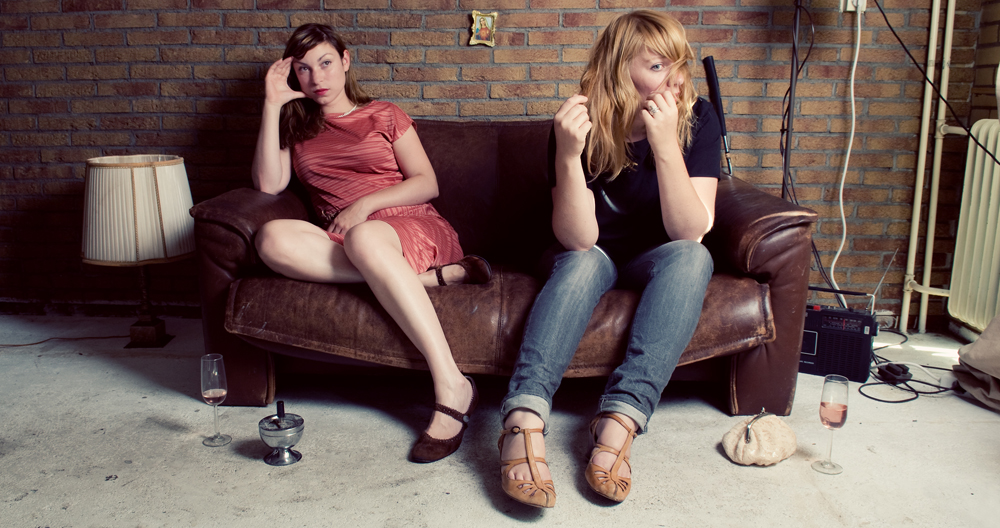
PHOTO BY PIM TOP
Studio Kimmo
Studio Kimmo, with its bases in Rotterdam, the Netherlands, and Gothenburg, Sweden, embodies the creative partnership of filmmakers Mirka Duijn and Nina Spiering.
Selected awards:
International Digital EMMY® Award, 2015
Peabody Award, 2019
Prix Europe, 2014
Mirka Duijn and Nina Spiering have a history of creating documentary, fiction, and experimental film projects, as well as journalistic productions such as The Industry and Last Hijack Interactive. Their projects always start with in-depth research, delving deeply into their chosen subjects. They have a particular interest in the mediation of place and identity.
The duo often works with archives and archival material, renegotiating historical narratives. Their most recent project, Shangri-La, Paradise under Construction, premiered at IDFA 2022 and competed for Best Dutch Film. Currently, they are working on Paradise Pt II, an ‘ABC about romantic clichés about nature’, questioning how the romantic-gaze on nature influenced human relations with their environment.
Download the Studio Kimmo portfolio/CV pdf (2023).
Studio Kimmo, with its bases in Rotterdam, the Netherlands, and Gothenburg, Sweden, embodies the creative partnership of filmmakers Mirka Duijn and Nina Spiering.
Selected awards:
International Digital EMMY® Award, 2015
Peabody Award, 2019
Prix Europe, 2014
Mirka Duijn and Nina Spiering have a history of creating documentary, fiction, and experimental film projects, as well as journalistic productions such as The Industry and Last Hijack Interactive. Their projects always start with in-depth research, delving deeply into their chosen subjects. They have a particular interest in the mediation of place and identity.
The duo often works with archives and archival material, renegotiating historical narratives. Their most recent project, Shangri-La, Paradise under Construction, premiered at IDFA 2022 and competed for Best Dutch Film. Currently, they are working on Paradise Pt II, an ‘ABC about romantic clichés about nature’, questioning how the romantic-gaze on nature influenced human relations with their environment.
Download the Studio Kimmo portfolio/CV pdf (2023).
The history of Studio Kimmo
Mirka began her career in 2003 at VPRO Digital, where she explored experimental interactive and transmedia storytelling across web and TV projects. By 2008, she shifted her focus entirely to writing and directing for film and media. Her earlier work often revolved around the evolving relationship between technology and storytelling, leading to interactive and immersive projects such as Last Hijack Interactive (Digital EMMY Award, 2014) and The Industry (Peabody Award, 2019).
Nina graduated from the University of the Arts in Utrecht in 2007 with a background in spatial design and video for theatre. She worked with leading Dutch theatre companies like Orkater and Oostpool before transitioning to film. Her early training in 3D space continues to shape her approach as both a director and production designer.
Their collaboration began in 2004, focusing on fiction and documentary filmmaking while also working in interactive documentary, expanded cinema, and immersive storytelling for film, television, and museum contexts. Their projects seek to challenge conventional narratives, experimenting with form and perspective to engage audiences in new ways of seeing and understanding the world.
Mirka Duijn is a Senior Lecturer in Film at HDK-Valand in Göteborg, where she teaches in the MFA Film program. Nina Spiering is a lecturer in film at the University of the Arts in Utrecht.
The Stories we Tell
We, humans, tell stories to understand the world. Storytelling is a way of structuring a chaos consisting of events, feelings, memories into an understandable, agreeable whole, consciously or unconsciously incorporating certain impressions, while leaving out others. The question is: How does one get from a set of experiences to a narrative? How does one shape the process from the first encounter, through the organisation of one's impressions, to a final story that does justice to the experienced reality? This question is at the core of all of our projects, not only for ourselves as makers, but in general in society: What narratives do people create to cope with reality?
“When you are in the middle of a story it isn't a story at all, but only a confusion; a dark roaring, a blindness, a wreckage of shattered glass and splintered wood; like a house in a whirlwind, or else a boat crushed by the icebergs or swept over the rapids, and all aboard powerless to stop it. It's only afterwards that it becomes anything like a story at all. When you are telling it, to yourself or to someone else.”
― Margaret Atwood, Alias grace (1996)
Mirka began her career in 2003 at VPRO Digital, where she explored experimental interactive and transmedia storytelling across web and TV projects. By 2008, she shifted her focus entirely to writing and directing for film and media. Her earlier work often revolved around the evolving relationship between technology and storytelling, leading to interactive and immersive projects such as Last Hijack Interactive (Digital EMMY Award, 2014) and The Industry (Peabody Award, 2019).
Nina graduated from the University of the Arts in Utrecht in 2007 with a background in spatial design and video for theatre. She worked with leading Dutch theatre companies like Orkater and Oostpool before transitioning to film. Her early training in 3D space continues to shape her approach as both a director and production designer.
Their collaboration began in 2004, focusing on fiction and documentary filmmaking while also working in interactive documentary, expanded cinema, and immersive storytelling for film, television, and museum contexts. Their projects seek to challenge conventional narratives, experimenting with form and perspective to engage audiences in new ways of seeing and understanding the world.
Mirka Duijn is a Senior Lecturer in Film at HDK-Valand in Göteborg, where she teaches in the MFA Film program. Nina Spiering is a lecturer in film at the University of the Arts in Utrecht.
The Stories we Tell
We, humans, tell stories to understand the world. Storytelling is a way of structuring a chaos consisting of events, feelings, memories into an understandable, agreeable whole, consciously or unconsciously incorporating certain impressions, while leaving out others. The question is: How does one get from a set of experiences to a narrative? How does one shape the process from the first encounter, through the organisation of one's impressions, to a final story that does justice to the experienced reality? This question is at the core of all of our projects, not only for ourselves as makers, but in general in society: What narratives do people create to cope with reality?
“When you are in the middle of a story it isn't a story at all, but only a confusion; a dark roaring, a blindness, a wreckage of shattered glass and splintered wood; like a house in a whirlwind, or else a boat crushed by the icebergs or swept over the rapids, and all aboard powerless to stop it. It's only afterwards that it becomes anything like a story at all. When you are telling it, to yourself or to someone else.”
― Margaret Atwood, Alias grace (1996)
Paradise Pt. II
Project under Development, 2024-2028
Paradise Pt II: Reimagining Nature Through Documentary Landscapes
Paradise Pt II is an ongoing research project with multiple outcomes amongst which an installation and a documentary film (dir. Nina Spiering) that are due to be developed in 2025 - 2028.
Paradise Pt II explores how romantic and idyllic representations of nature have shaped Western perceptions and interactions with natural environments. This project investigates how such imagery, rooted in modernity and reinforced through visual culture, continues to influence our environmental consciousness by presenting nature as something separate from humanity—an object of beauty and a resource for consumption. As environmental challenges become increasingly pressing, re-examining these visual traditions takes on increased significance.
As a documentary filmmaker, we aim to critically engage with these visual traditions to challenge their inherited meanings and reframe them in ways that inspire alternative narratives. Through a series of concrete case studies, Paradise Pt II will explore the genealogy of romantic clichés and their impact, with the goal of subverting their allure and fostering more responsible, reciprocal relationships with the natural world.
A key conceptual framework for this research is the idea of the garden and paradise as spaces of contestation—representing spaces of exclusion and control yet also offering a fertile ground for utopian imaginaries. This proposition resonates with Michel Foucault’s concept of heterotopia, which proposes the garden as a site that reflects and reimagines broader cultural and natural landscapes. Within this analogy, the documentary filmmaker becomes a gardener—curating and assembling imagery of nature to nurture new perspectives on natural environments.
This research contributes to the fields of documentary filmmaking, environmental studies, and visual culture by offering new strategies for engaging with nature in ways that challenge dominant narratives and inspire critical reflection.General interest
In the quest to make sense of their environment, humans rely on narratives, stories and myths that they tell themselves and others. But the narratives that are shaped around our relation to nature are heavily influenced by the natural colonial-gaze, a lens through which nature has often been perceived as a realm to be dominated and controlled.
Throughout history, narratives have shaped our perception of nature as an external, pristine entity, fostering an idealized escape from the complexities of human existence. However, this idealized portrayal has hindered our capacity to foster a holistic and sustainable rapport with the environment, resulting in a disconnect between our constructed stories and the complex realities they represent.
Despite the growing awareness of the need for a paradigm shift in our narrative approach to nature, we continue to struggle in reconciling the preconceived notions of the romanticized and enlightened views of nature. This tension between the constructed narrative and the authentic reality of our environmental challenges has led to a profound disconnect, perpetuating the colonial proposition that nature exists solely for our exploitation and benefit.
![]() Telephone poles disguised as trees in Utah.
Telephone poles disguised as trees in Utah.
In exploring the contemporary landscape and tracing the historical trajectory of humanity's portrayal of nature, it becomes evident that the roots of this dissonance can be found in the flawed narratives that have long dominated our understanding of the natural world.
Paradise Pt II project will exist out of a mosaic of case studies around this proposition. We are working with cases where there is a tension between the narrative that is created and the underlying represented reality, the synthetic and the real. We will both focus on the present day, as well as tracing back history of the image of nature, asking ourselves the question: where and how did it go wrong, and with what consequences?
![]() The first sequoia tree that was transported to a world fair in the US, after being ‘discovered’ in California by Western settlers. The bark was peeled off the original tree, transported and assembled at the fair. The tree was assembled so poorly, that visitors thought the it was a fake, a hoax, and for several years the discovery was not taken seriously at all.
The first sequoia tree that was transported to a world fair in the US, after being ‘discovered’ in California by Western settlers. The bark was peeled off the original tree, transported and assembled at the fair. The tree was assembled so poorly, that visitors thought the it was a fake, a hoax, and for several years the discovery was not taken seriously at all.
Paradise Pt II is an ongoing research project with multiple outcomes amongst which an installation and a documentary film (dir. Nina Spiering) that are due to be developed in 2025 - 2028.
Paradise Pt II explores how romantic and idyllic representations of nature have shaped Western perceptions and interactions with natural environments. This project investigates how such imagery, rooted in modernity and reinforced through visual culture, continues to influence our environmental consciousness by presenting nature as something separate from humanity—an object of beauty and a resource for consumption. As environmental challenges become increasingly pressing, re-examining these visual traditions takes on increased significance.
As a documentary filmmaker, we aim to critically engage with these visual traditions to challenge their inherited meanings and reframe them in ways that inspire alternative narratives. Through a series of concrete case studies, Paradise Pt II will explore the genealogy of romantic clichés and their impact, with the goal of subverting their allure and fostering more responsible, reciprocal relationships with the natural world.
A key conceptual framework for this research is the idea of the garden and paradise as spaces of contestation—representing spaces of exclusion and control yet also offering a fertile ground for utopian imaginaries. This proposition resonates with Michel Foucault’s concept of heterotopia, which proposes the garden as a site that reflects and reimagines broader cultural and natural landscapes. Within this analogy, the documentary filmmaker becomes a gardener—curating and assembling imagery of nature to nurture new perspectives on natural environments.
This research contributes to the fields of documentary filmmaking, environmental studies, and visual culture by offering new strategies for engaging with nature in ways that challenge dominant narratives and inspire critical reflection.General interest
In the quest to make sense of their environment, humans rely on narratives, stories and myths that they tell themselves and others. But the narratives that are shaped around our relation to nature are heavily influenced by the natural colonial-gaze, a lens through which nature has often been perceived as a realm to be dominated and controlled.
Throughout history, narratives have shaped our perception of nature as an external, pristine entity, fostering an idealized escape from the complexities of human existence. However, this idealized portrayal has hindered our capacity to foster a holistic and sustainable rapport with the environment, resulting in a disconnect between our constructed stories and the complex realities they represent.
Despite the growing awareness of the need for a paradigm shift in our narrative approach to nature, we continue to struggle in reconciling the preconceived notions of the romanticized and enlightened views of nature. This tension between the constructed narrative and the authentic reality of our environmental challenges has led to a profound disconnect, perpetuating the colonial proposition that nature exists solely for our exploitation and benefit.
 Telephone poles disguised as trees in Utah.
Telephone poles disguised as trees in Utah. In exploring the contemporary landscape and tracing the historical trajectory of humanity's portrayal of nature, it becomes evident that the roots of this dissonance can be found in the flawed narratives that have long dominated our understanding of the natural world.
Paradise Pt II project will exist out of a mosaic of case studies around this proposition. We are working with cases where there is a tension between the narrative that is created and the underlying represented reality, the synthetic and the real. We will both focus on the present day, as well as tracing back history of the image of nature, asking ourselves the question: where and how did it go wrong, and with what consequences?
 The first sequoia tree that was transported to a world fair in the US, after being ‘discovered’ in California by Western settlers. The bark was peeled off the original tree, transported and assembled at the fair. The tree was assembled so poorly, that visitors thought the it was a fake, a hoax, and for several years the discovery was not taken seriously at all.
The first sequoia tree that was transported to a world fair in the US, after being ‘discovered’ in California by Western settlers. The bark was peeled off the original tree, transported and assembled at the fair. The tree was assembled so poorly, that visitors thought the it was a fake, a hoax, and for several years the discovery was not taken seriously at all.Shangri-La, Paradise under Construction
Research, 2015 - 2025


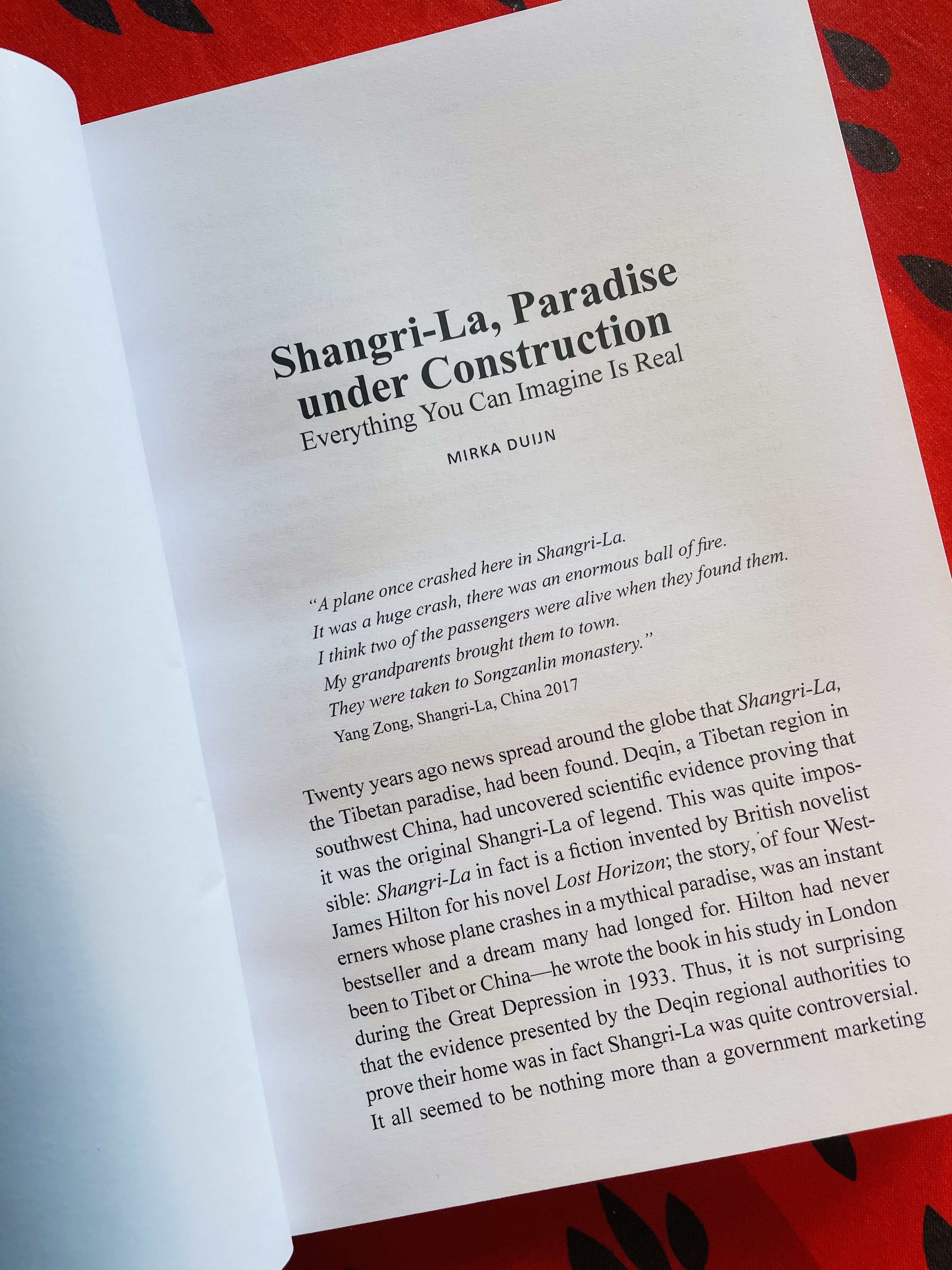

The documentary ‘Shangri-La, Paradise under Construction’ (2023) is part of a longer research trajectory.
When it comes to believing things without actual evidence, we all incline to what we find most attractive. - James Hilton, Lost Horizon, 1933
The research is rooted in the field of documentary filmmaking and centers around the concept of the representation of reality, particularly within the context of post-colonial discourse. Operating as documentary filmmakers in the contemporary post-truth era, which is characterized by the prevalent discussions regarding fake news and the decline of factual accuracy in media, our objective is to investigate the various approaches that documentary filmmakers can employ to participate in a realm of representation that extends beyond, and sometimes challenges, the dynamics of mass media. This endeavor is guided by the aim of decolonizing documentary practices, focussing on a.o., polyvocality as cinematic strategy.
Within this broader context, our study focuses on mass media in relation to tourism. It acknowledges the concept of the tourist gaze, as articulated by John Urry in 1990, as a contemporary extension of the colonial gaze. our research focuses on a specific case study, namely, a marketing campaign designed to promote Shangri-La, a Tibetan town in China, as a prominent tourist destination. This campaign has been constructed upon the political and cultural legacy of the colonial gaze directed toward Tibet. In the pursuit of this research, we have traced the historical evolution of the image associated with Shangri-La and Tibet, commencing from the contemporary era and meticulously retracing it back to the colonial depictions in film as well as photography. This exploration highlights how the contemporary image is intrinsically linked as a legacy of the colonial representations.
The outcome of this research has been multifold: Mirka Duijn and Nina Spiering have given lecture performances, have written publications and exhibited installations (see below) in the context of this research, while at the same time working towards the final documentary essay.
The documentary film was completed in the fall of 2022, and its TV counterpart in the spring of 2023. Mirka Duijn is currently finishing her Ph.D. thesis, the focus is on advancing towards the finalization of the written component of the thesis. In line with the polyvocal approach of the film, the written component will be based on a series of conversations with specialists in the field of documentary film, artistic research and archival practices.
Aim of this research
We live in a time in which rhetoric about fake news, the death of facts and even ‘the collapse of reality’ prevail. As a documentary maker, concerned with the representation of reality, we think it is more important than ever to be the one who critically and actively seeks to engage in a sphere of representation beyond – or even in opposition to – mass media and its dynamics. Starting from a process-relational (performative) take on reality in relation to the act of filmmaking, questioning the representation of reality and subsequent interaction with/appropriation of the image, I try to understand the image not as the neutral picturing of reality but as a way of coming to terms with reality through images and narrative. Being documentary makers, this research starts from within the cinematic practice, thinking through images and sounds, using the filmmaking practice as a conceptual framework, a methodological vehicle (filming, editing, framing) and as a means of dissemination.


Installation in Eye Museum, 2015
Publication in I Experience as I Experiment, I Experiment as I Experience, KUVA, Denise Ziegler (2019)

Shangri-La, Paradise under Construction
Documentary, 2023




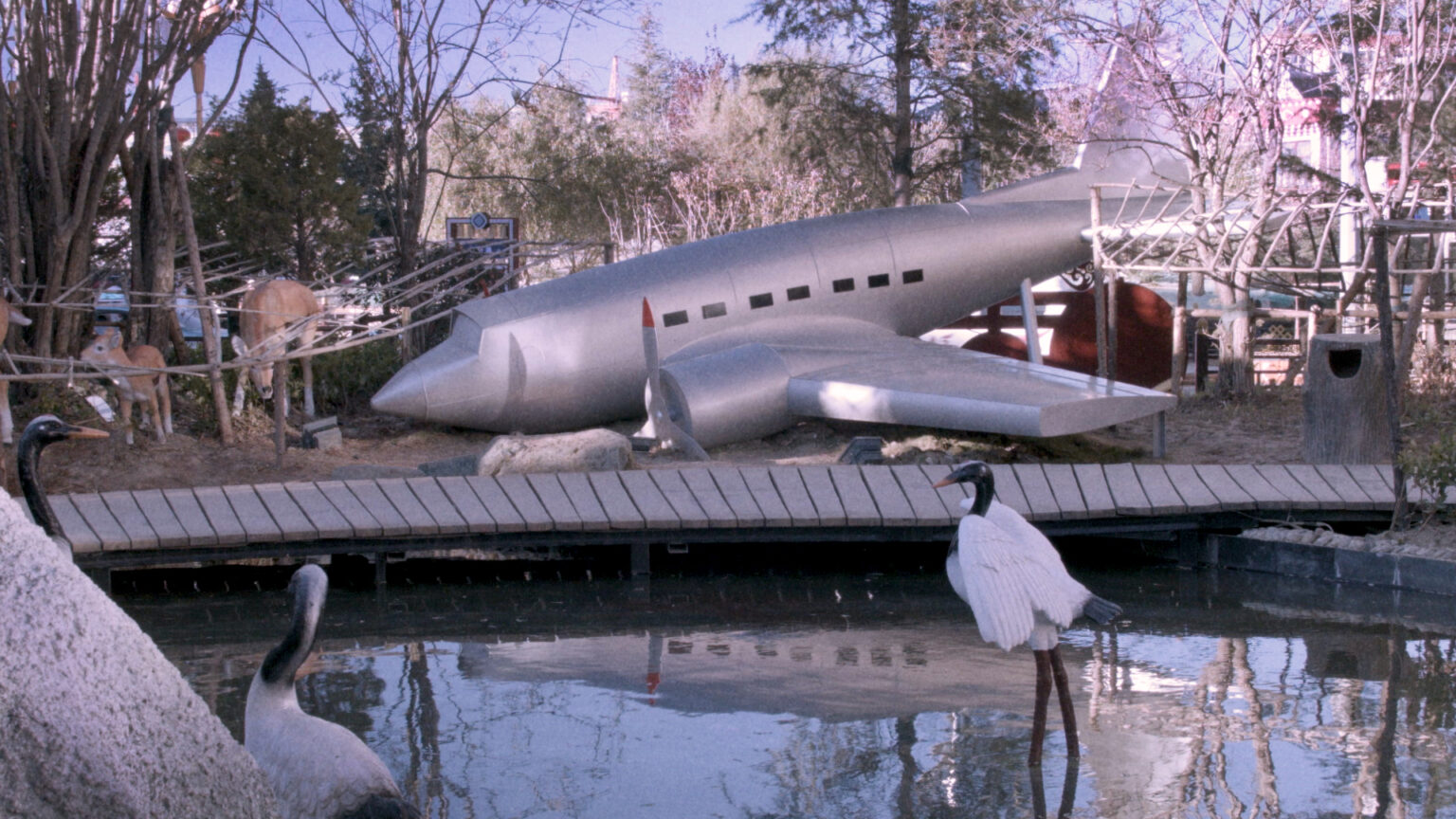
Directors: Mirka Duijn & Nina Spiering
A travelogue through Shangri-La; the fictitious paradise from the classic novel Lost Horizon (1933). Twenty years ago a Tibetan tourist spot in China presented scientific proof that it was the real Shangri-La. In her search for the truth behind the supposed evidence the filmmaker excavates layers of fact and fiction of the area. What words and images have attached themselves to facts? How do stories come into being and how do they shape reality?
Presently, the film is being internationally distributed, making its way to various festivals, television broadcasts, and video-on-demand platforms.
The film is part of a wider research project, with multiple outcomes, amongst which publications, installations and lecture performances. Read more about the research behind the project here.
Distribution
TV
SVT Sweden, 2023
NPO Netherlands, due in 2023
Festivals
World premiere at IDFA, International Film Festival in Amsterdam, 2022, in competition for Best Dutch Documentary.
DocPoint Tallin/Helsinki 2023, Trento Internation
al Film Festival 2023, Millennium Docs Against Gravity Warsaw 2023 Dutch Film Festival 2023
Film Theatre
Theatrical release in 23 film theatres in the Netherlands in January 2023.
VOD/TVOD
World wide: Amazon Prime, Apple. Youtube pay per view.
Nominations, prices
Nominated ‘Best Dutch Documentary at IDFA, 2022’, Nominated Best Film Music for Documentary, BUMA Netherlands, 2023’, in Competition at Trento Film Festival, 2023, in Competition at Millennium Docs Against Gravity Warsaw 2023
SVT Sweden, 2023
NPO Netherlands, due in 2023
Festivals
World premiere at IDFA, International Film Festival in Amsterdam, 2022, in competition for Best Dutch Documentary.
DocPoint Tallin/Helsinki 2023, Trento Internation
al Film Festival 2023, Millennium Docs Against Gravity Warsaw 2023 Dutch Film Festival 2023
Film Theatre
Theatrical release in 23 film theatres in the Netherlands in January 2023.
VOD/TVOD
World wide: Amazon Prime, Apple. Youtube pay per view.
Nominations, prices
Nominated ‘Best Dutch Documentary at IDFA, 2022’, Nominated Best Film Music for Documentary, BUMA Netherlands, 2023’, in Competition at Trento Film Festival, 2023, in Competition at Millennium Docs Against Gravity Warsaw 2023
International Sales:
Journeyman Pictures
Produced by:
De Productie (NL),
Film Kreatörerna (SE),
Studio Kimmo (NL)
Funded by:
Dutch Film Fund,
Amsterdam Fund for the Art
Swedish Film Fund.
Read the reviews in Newspapers:
NRC Newspaper ︎︎︎︎
Volkskrant ︎︎︎
Fries Dagblad ︎︎︎︎
Telegraaf ︎︎︎1/2
Parool review
Trouw review
Filmkrant review
Read the international Modern Times Review:
“In their film Shangri-La, Paradise under Construction, directors Mirka Duijn and Nina Spiering reconsidered the most basic premises of documentary filmmaking – truth, evidence, and interpretation.”
“Even if the fantastic nature of Shangri-La might indicate that this documentary will be about fantasy, it is not. The key theme of Shangri-La, Paradise Under Construction, is the reality and the mysterious ways of its construction.” - Melita Zajc

Read the international IDA-review:
“A film that richly explores the creation of meaning from different perspectives that infuse the project of “paradise under construction,” and leaves viewers with hard questions to ask themselves about exoticization and power.” - Patricia Aufderheide

Other media:
Listen to an interview on Opium Radio (in Dutch).
Interview in the Dutch Film Newspaper: Filmkrant (in Dutch).
Interview in SEE.NL (in English).
Listen to an interview on the Ketelhuis Podcast (In Dutch).

Land of Change
Documentary, museum 2013

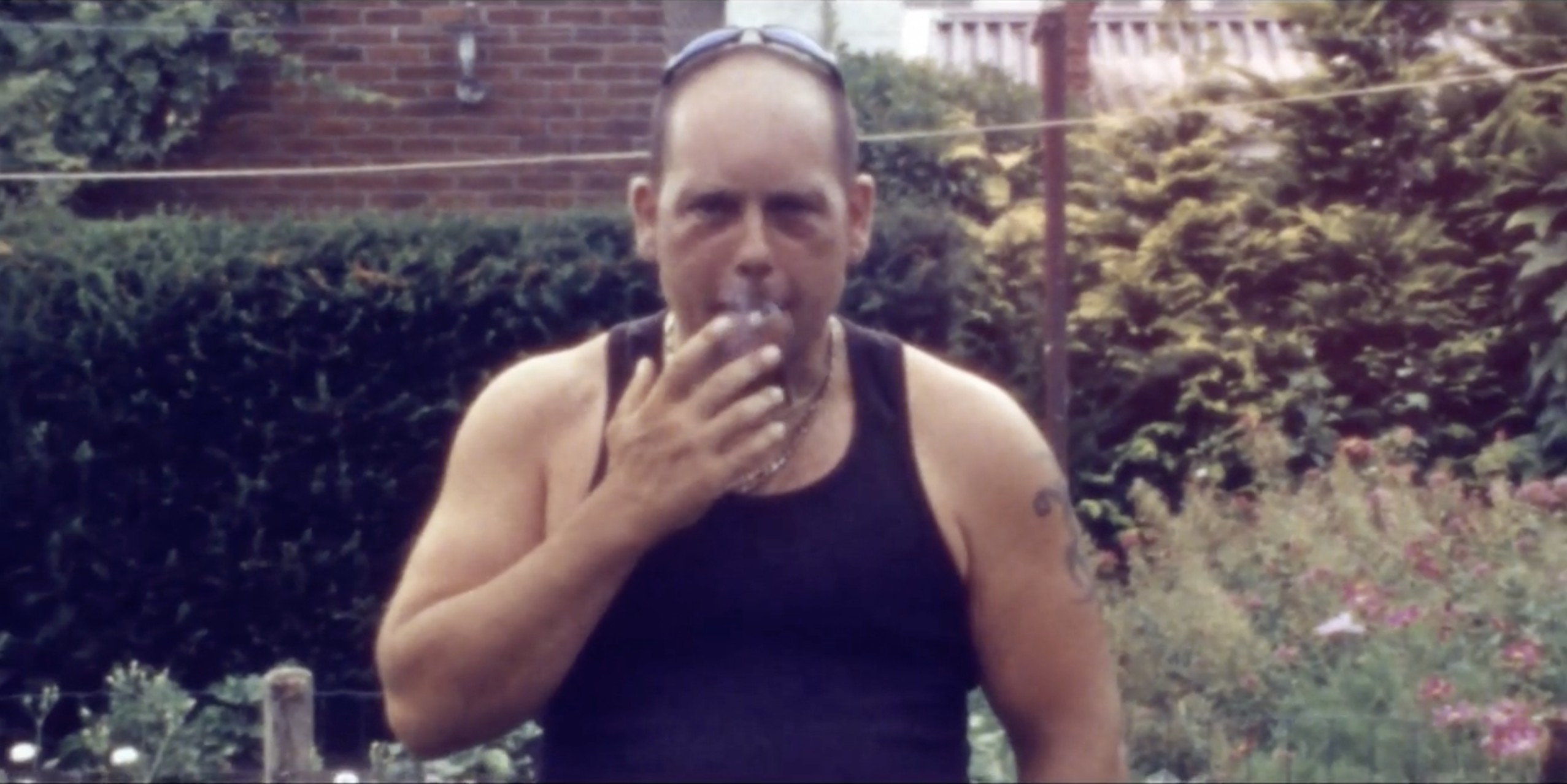


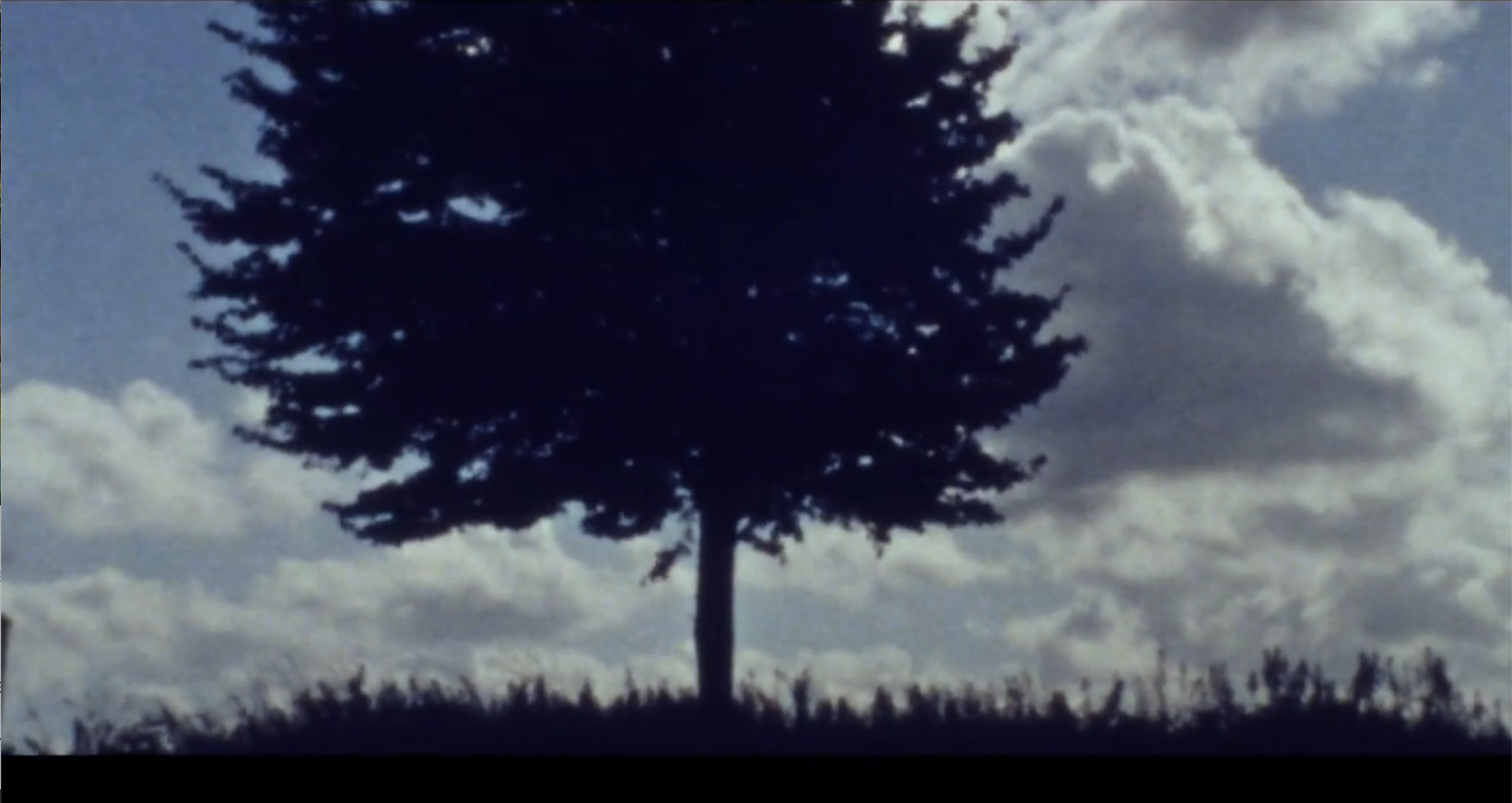


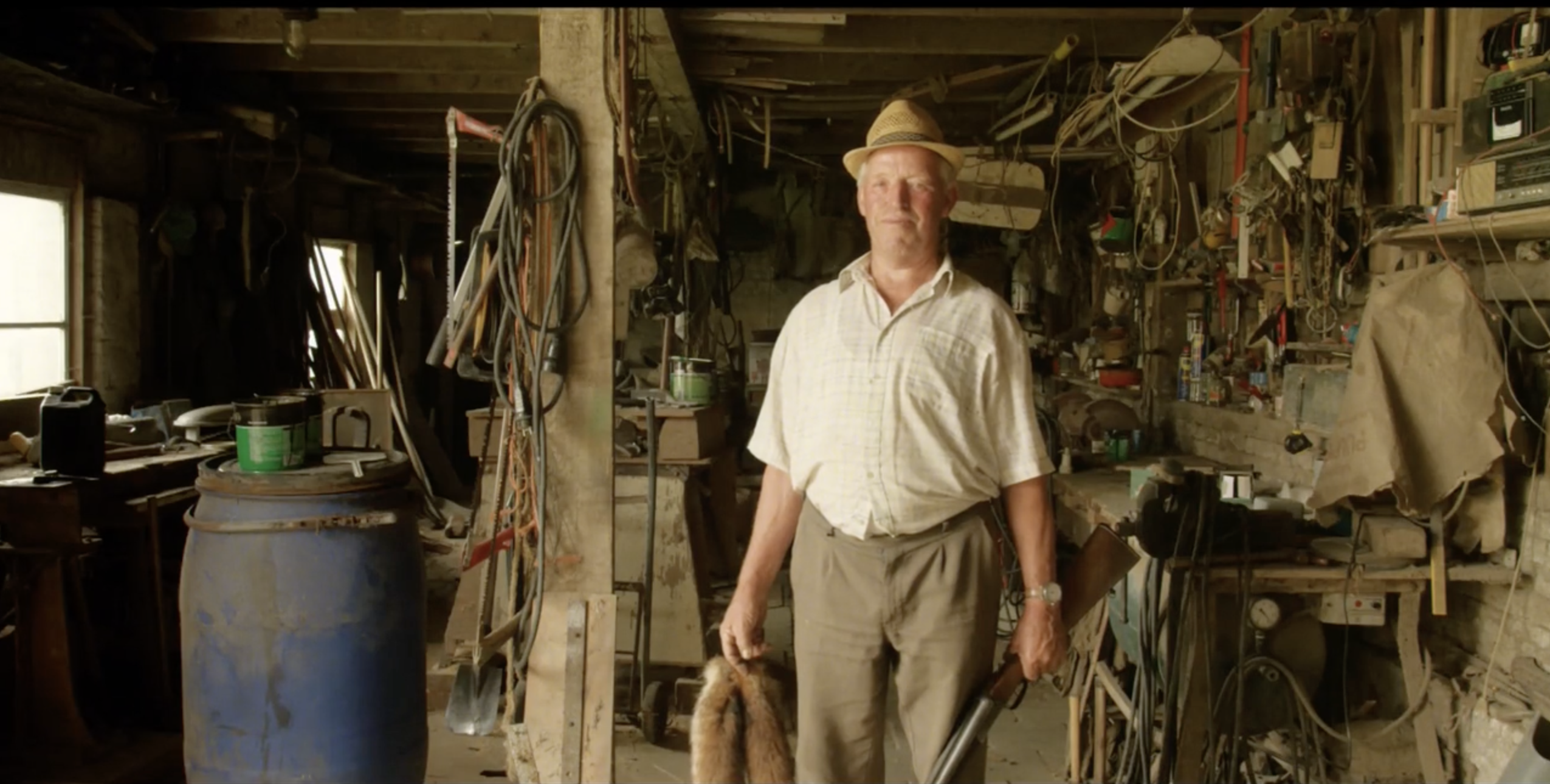






Land of Change, the Zeeland Archives Project (2013)
Directors: Mirka Duijn & Nina Spiering
What is it like to live in a region where everything is changing? How do you deal with the loss, but also with the new gains? This film project holds a collage of portraits of inhabitants of the Dutch region West Zeeuws-Vlaanderen, amidst the marches, mudflats and the ever-present wind.
This film was made for the Dutch Zeeuws Museum. It has been developed as a part of their Islands Archive Project eilanden.net. The museum asked inhabitants of Zeeland to make films about aspects of or objects from/in Zeeland that they would like to be ‘remembered forever’. The films were stored in the Islands Archive.
The purpose of this request was to get a gestalt view of the present-day cultural identity of Zeeland. As we watched these films, we asked ourselves: are the subjects filmed by the participants indeed being ‘remembered’ by being added to this archive? Can one glean any knowledge about the present-day cultural identity of Zeeland from this archive? And how could we, filmmakers, add to this act of remembering, by restructuring and (re)visualise the contents of the archive?
For this project we took the films from the Zeeland archive as a base for a new narrative, which is build around several core portraits of inhabitants of Zeeland. Some of the found footage is used as-is, but most of it is repurposed around recurring themes.
More information about the film:
West Zeeuws-Vlaanderen is a secluded part of the Netherlands. It is not connected to the Netherlands by land, you can only get there over water or through a tunnel, and you have to pay for both options.
Over centuries this area has been in constant change. The geography, the sea and the constant battle against the seawater dictated most of the changes.
Nowadays the changes in the region are of a different kind. The geography still plays a big part in it though: just as in many other secluded area’s in Europe, Zeeuws-Vlaanderen is rapidly changing because of macro-economic changes. A lot of old industries are dying. For ages most inhabitants were farmers and fishermen. But now the fishing industry hardly exists anymore; it disappeared within the last 20 years. Next to that, as a result of the expansion of farms, a lot of farmers are leaving the region. Finally, also young people leave: There is no work for them in the area. As a result the population is aging rapidly. These changes have been going on for years, but at this moment the changes are gaining momentum. The government tries to deal with the problems by focusing on a new industry: tourism. Polders are dug out to give space for artificial lakes and grand marina’s.
The local inhabitants find themselves amid this transformative period: much has already vanished, yet the emergence of new developments is still on the horizon. They are holding their breath while waiting for the tourists to come.
This film is a poetic collage of portraits of inhabitants of the area. Among them, for example, skipper Jaap Albrechtse (63), who retires from his work and sails his ship to Africa. And the 22-year-old Mariëlle Notebaart. At workdays you can find her behind the counter of the Texaco gas station. During festivities she has got an other job though: she is elected to be the towns’ ‘Shrimp Princess’. Another character is Foort Lokerse (59), the head of the fish auction. He wants to turn his fish auction into a Fish Experience for tourists for whom he will place a ship on the roof of his building; it will be his own fish theme park. He hopes it will save the identity of Breskens as a fishing town.
The portraits of Jaap, Mariëlle, Foort and many others together form one story, the story about change in West Zeeuws-Vlaanderen.
Broeder Dieleman, musician from Zeeuws-Vlaanderen (internationally known for his collaborations with a.o., Bonnie Prince Billy, has made almost all the music for the film. His music, together with the sound of water, wind and seagulls, forms a base for the rhythm of the film.
This film was made for the Dutch Zeeuws Museum. It has been developed as a part of their Islands Archive Project eilanden.net. The museum asked inhabitants of Zeeland to make films about aspects of or objects from/in Zeeland that they would like to be ‘remembered forever’. The films were stored in the Islands Archive.
The purpose of this request was to get a gestalt view of the present-day cultural identity of Zeeland. As we watched these films, we asked ourselves: are the subjects filmed by the participants indeed being ‘remembered’ by being added to this archive? Can one glean any knowledge about the present-day cultural identity of Zeeland from this archive? And how could we, filmmakers, add to this act of remembering, by restructuring and (re)visualise the contents of the archive?
For this project we took the films from the Zeeland archive as a base for a new narrative, which is build around several core portraits of inhabitants of Zeeland. Some of the found footage is used as-is, but most of it is repurposed around recurring themes.
More information about the film:
West Zeeuws-Vlaanderen is a secluded part of the Netherlands. It is not connected to the Netherlands by land, you can only get there over water or through a tunnel, and you have to pay for both options.
Over centuries this area has been in constant change. The geography, the sea and the constant battle against the seawater dictated most of the changes.
Nowadays the changes in the region are of a different kind. The geography still plays a big part in it though: just as in many other secluded area’s in Europe, Zeeuws-Vlaanderen is rapidly changing because of macro-economic changes. A lot of old industries are dying. For ages most inhabitants were farmers and fishermen. But now the fishing industry hardly exists anymore; it disappeared within the last 20 years. Next to that, as a result of the expansion of farms, a lot of farmers are leaving the region. Finally, also young people leave: There is no work for them in the area. As a result the population is aging rapidly. These changes have been going on for years, but at this moment the changes are gaining momentum. The government tries to deal with the problems by focusing on a new industry: tourism. Polders are dug out to give space for artificial lakes and grand marina’s.
The local inhabitants find themselves amid this transformative period: much has already vanished, yet the emergence of new developments is still on the horizon. They are holding their breath while waiting for the tourists to come.
This film is a poetic collage of portraits of inhabitants of the area. Among them, for example, skipper Jaap Albrechtse (63), who retires from his work and sails his ship to Africa. And the 22-year-old Mariëlle Notebaart. At workdays you can find her behind the counter of the Texaco gas station. During festivities she has got an other job though: she is elected to be the towns’ ‘Shrimp Princess’. Another character is Foort Lokerse (59), the head of the fish auction. He wants to turn his fish auction into a Fish Experience for tourists for whom he will place a ship on the roof of his building; it will be his own fish theme park. He hopes it will save the identity of Breskens as a fishing town.
The portraits of Jaap, Mariëlle, Foort and many others together form one story, the story about change in West Zeeuws-Vlaanderen.
Broeder Dieleman, musician from Zeeuws-Vlaanderen (internationally known for his collaborations with a.o., Bonnie Prince Billy, has made almost all the music for the film. His music, together with the sound of water, wind and seagulls, forms a base for the rhythm of the film.
Fragments from the film (7:30”).
The full film can be seen here.

The film has been added to the permanent collection of the Zeeuws Museum. After having been exhibited in the temporary Islands Exhibition in 2014,the film was added to the permanent exhibition from 2017 to 2022, becoming an integral part of their curated showcase.
Produced by: Zeeuws Museum, Serious Film, Studio Kimmo.
Press:
VPRO, DE AVONDEN
NPS, LIJN 1
PZC
PZC & OMROEP ZEELAND @ FILM BY THE SEA
Film & Philosophy Conference:
http://www.film-philosophy.com